Neuraxial techniques are considered to be the gold standard for intrapartum pain relief in labouring patients because of their superior analgesia and maternal satisfaction, improved safety, and favourable maternal–foetal physiology [1]. Addition of opioids to local anaesthetics in epidural analgesia, provide a local anaesthetic dose sparing effect, increase the duration and quality of analgesia, but their use is associated with adverse effects such as drowsiness, nausea, and vomiting in the mother, and respiratory depression in the neonate [2-4].
Paracetamol is a readily available nonopioid analgesic and antipyretic which is safe, effective, inexpensive, simple to administer and requires no special monitoring [5]. When compared to other opioids, and nonsteroidal anti-inflammatory drugs, paracetamol has a favourable safety profile without any risk of congenital anomalies [6-8]. Though its role as an intrapartum analgesic drug in labouring patients has been adequately studied by various authors [9-15], there is paucity of work on its neuraxial local anaesthetic opioid dose sparing effects. One study undertaken by Gupta K et al., demonstrated epidural drug (levobupivacaine 0.1% and fentanyl 2 μg/mL) sparing effects of i.v. paracetamol [16].
If proved to be having an effective epidural drug sparing effect in labour, paracetamol being freely available and simple to administer could be an integral part of multimodal labour analgesia. Thus, it appeared natural to design a randomised trial to investigate the effectiveness and unfavourable side-effects (if any) of an i.v. infusion of 1000 mg of paracetamol when used along with PCEA in labouring women.
The aim of present study was to evaluate the efficacy of i.v. paracetamol as an adjunct and its dose sparing effect on total consumption of ropivacaine and fentanyl solution given as PCEA in labouring parturient with the primary objective to evaluate mean hourly consumption of epidurally administered ropivacaine and fentanyl starting from one hour after study drug infusion till delivery.
In this study, it was hypothesised that addition of i.v. paracetamol as an adjunct to epidural analgesia will reduce mean hourly consumption of epidurally administered ropivacaine and fentanyl for duration of epidural labour analgesia.
Materials and Methods
The present study was a randomised controlled trial, was conducted in 88 parturients from March 2019 to January 2020 at two tertiary level hospitals associated with Dr SN Medical College, Jodhpur, Rajasthan, India. Institutional Ethics Committee approval (certificate no: SNMC/IEC/2019/37 dated 06/03/2019) was taken and written informed consent from each of study subjects was obtained.
Sample size calculation: Sample size was calculated on the basis of previous study by Gupta K et al., which showed that the hourly mean epidural drug consumption in the paracetamol group was 7.03 mL/hour and in control was 8.12 mL/hour [16]. To have a power of 80% with an α error of 0.05 and a significance level of 5%, 44 patients were required in each group.
Inclusion criteria
Primigravida or gravida 2,
Singleton pregnancy with vertex presentation at term,
Parturients in established labour with cervical dilation >3 cm and having satisfactory uterine contractions,
VAS values >3 at the peak of contraction and
Parturients assessed and approved by obstetrician for normal vaginal delivery.
Exclusion criteria
Parturients with history of anaphylaxis to local anaesthetics and allergy to the drugs used and
Any contraindication to epidural catheter placement like patient refusal, coagulopathy and local site infection.
Labour analgesia and its effects were explained to the parturients. After detailed history taking and a complete general physical examination including airway assessment, spine and systemic examination the subjects were evaluated by the obstetrician for cervical dilatation, effacement, station and integrity of membranes. All parturients were continued on clear oral fluid, an i.v. cannula was placed and Ringer Lactate solution 500 mL infusion started. Just before study drug infusion baseline pain score was assessed using visual analogue pain scale with the 0 denoting no pain, while 10 denoting the worst possible pain [17].
Randomisation and Blinding
The study participants were randomly allocated to two groups of 44 each by computer generated random numbers with allocation concealment using serially numbered opaque envelops that were only released after recruitment. For both groups, the study drug was administered at the beginning of the active phase of labour (defined as a cervical dilatation of 3-5 cm and a cervical effacement ≥50%).
The Paracetamol group (Group P, n=44) received a 100 mL i.v. infusion containing 1000 mg of paracetamol (Pyricool, Alkem health Science, Namthang, Sikkim, India) over 10 minutes.
Control group (Group C, n=44) received an i.v. infusion of 100 mL of normal saline (NS, Albert David limited, Ghaziabad, UP, India) over 10 minutes, 20 minutes before the epidural catheter placement.
All observers and subjects were blinded to study group allocation. To maintain the double blinding, after randomisation, study drugs paracetamol and saline bottles were covered with opaque paper and were infused by anaesthesiology resident not further involved in the study. After finishing this infusion, study drug bottles were discarded and parturient was wheeled to procedure room and handed over to primary investigator who was blinded to the group allocation and drug received by the parturient.
So, the study drugs were infused 20 minutes before the epidural placement, as approximately this much time was required for shifting of patient to procedure room, handover to primary investigator, monitor application, positioning, painting and draping before epidural catheter placement was attempted.
Epidural Placement Protocol
In procedure room standard monitors, including automated non invasive arterial blood pressure, pulse oximeter and foetal cardiotocograph were applied. Baseline recording of Heart Rate (HR), Mean Arterial Pressure (MAP) and Oxygen saturation (SpO2) and Foetal Heart Rate (FHR) were noted. Epidural block with 18G, 8.5 cm Tuohy epidural needle and 20 G, closed end, multiport epidural catheter placement were done in standard manner. It was diligently tried to complete the procedure within 20 minutes of receiving the study drug. All parturients received an initial loading epidural dose consisting of 0.125% ropivacaine and 2 μg/mL fentanyl, 10 mL over 10 minutes in 3 mL aliquots after negative aspiration for blood and cerebrospinal fluid. The time at the completion of loading dose was designated as time 0 (t=0) and outcome assessments were done accordingly. This initial loading dose served as the test dose, which was given gradually under monitoring for any signs of inadvertent intrathecal or intravascular placement. Thus, study drug was infused 30 minutes before time 0. If the onset of analgesia (VAS <3) did not occur within 30 minutes of epidural activation, a further bolus 10 mL of epidural solution was given over 10 minutes as rescue analgesia and the parturient was withdrawn from the study.
Thirty minutes after the initial bolus dose and one hour after the study drug infusion, PCEA pump with the same epidural solution (ropivacaine 0.125% and fentanyl 2 μg/mL) at continuous background infusion of 5 mL/h was started through the epidural catheter. The parturients were provided with a remote-controlled hand-held button and there was provision of patient-controlled boluses of 5 mL of the same drug with a lockout interval of 15 min if needed. Each parturient was given written information on how to use the pump, and the concept of patient-controlled analgesia were explained to each one prior to the initiation of the study. In this way, all parturients were trained to press a button at a time when the pain disrupted their comfort, or when the pain intensified (VAS >3). All parturients were nursed in either left lateral position or were given a 30° wedge under her right hip throughout labour. Epidural catheter was removed after the delivery of foetus.
The labour evolution of parturients was documented on partogram and monitored by the obstetrician, including uterine contractility and cervical dilation clinically; and FHR with the help of a foetal cardiotocography.
Outcome Assessment
Outcome assessments were done by the primary investigator immediately after the complete administration of the initial 10 mL bolus dose of epidural drug solution (t=0) and at every 5 min for first 30 minutes, every 15 minutes for 60 minutes and then every hour till the delivery of the baby with any anaesthetic interventions, including requests to evaluate analgesia or side-effects (hypotension, pruritus, nausea, and foetal bradycardia); and immediately after delivery.
The primary outcome of the study was hourly average consumption of epidural drug volume, including both continuous background infusion plus bolus doses (in mL) starting from one hour after study drug infusion (or 30 minutes after initial epidural bolus completion), till delivery. The hourly average consumption was used as a measure of paracetamol efficacy instead of total drug volume consumption because of variable duration of labour in different subjects. The hourly average consumption was calculated as a mean value (mL/h) by dividing the total consumption of epidural drug volume by the duration of labour from t=30 minutes till delivery in hours. Secondary outcomes were VAS values, maximal sensory dermatomal levels achieved, degree of motor blockade, maternal haemodynamic parameters, duration of second stage of labour, foetal APGAR scores, modes of delivery, maternal satisfaction and maternal side-effects if any.
Analgesia was evaluated by VAS scores indicator after every uterine contraction. Time to onset of analgesia was recorded from the time when the epidural bolus drug was injected, to the time when VAS became less than three.
Sensory levels were assessed using wisp of cotton soaked in spirit in mid clavicular line bilaterally from upper thoracic to lumbar dermatomes and motor blockade was assessed from score 0 to 3 with a modified Bromage score [18]. Presence of motor blockade was defined as modified Bromage scale score ≥1.
Parturients vital parameters (HR, MAP and SpO2) and FHR were documented throughout the study. Hypotension was defined as systolic blood pressure of <90 mmHg and was treated with 100 to 200 mL bolus of IV fluids and if required, i.v. phenylephrine 50 μg. If maternal bradycardia occurred at any time (HR ≤50 beats/min) i.v. inj atropine 0.6 mg was given stat. Foetal heart rate and APGAR scores at 1 and 5 minutes were recorded, as was the maternal satisfaction at a postprocedure visit between 24 hours to 36 hours after delivery. Duration of 2nd stage of labour was noted. The time from the full opening of cervix to the birth of the baby was recorded as the 2nd stage. Occurrence of any side-effects like shivering, pruritus, nausea, vomiting, respiratory depression or urinary retention were noted and treated accordingly.
The flow diagram of patients is depicted in the Consolidated Standards of Reporting Trials (CONSORT) diagram [Table/Fig-1].
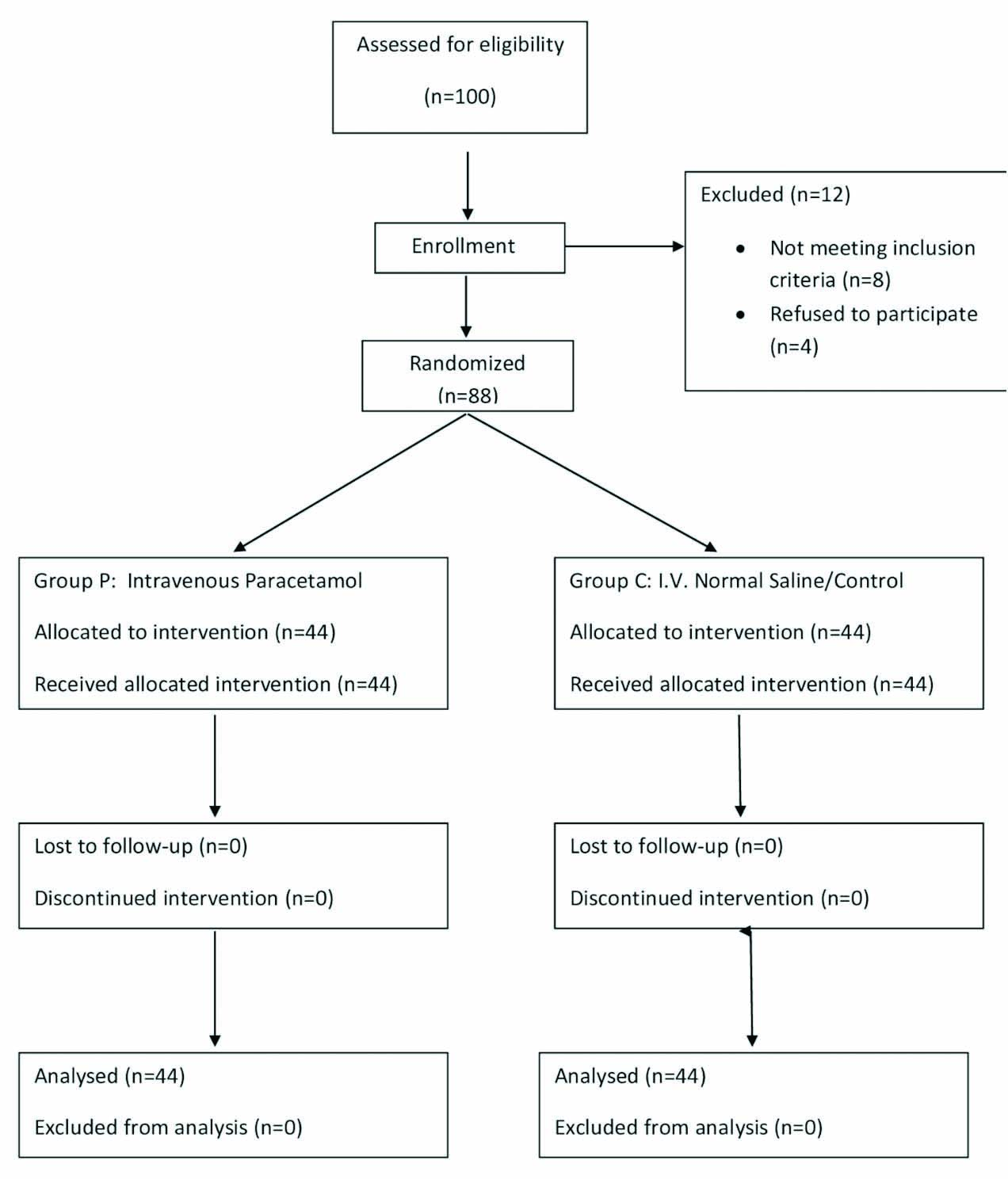
Statistical Analysis
Summary data were analysed by using Statistical Package for the Social Sciences (SPSS) for window Version 22.0. Statistical comparison was carried out using the Yates continuity correction test Chi-square or Fisher’s-exact test for non parametric data. Parametric data was analysed using Student’s t-test. Numerical variables were presented as frequency, percentages and mean±standard deviation and categorical variables were presented as frequency (%). A probability value (p-value) ≤0.05 was considered statistically significant.
Results
All the parturients achieved adequate analgesia within 30 minutes of administration of initial loading dose of epidural drug and none was excluded from analysis. The two groups were well matched for age, weight, height, gestation period and cervical dilatation at the time of study drug infusion as shown in [Table/Fig-2].
Parturient characteristics and obstetric parameters.
| Parameter (Mean±SD) | Group P | Group C | p-value (unpaired student’s t-test) |
|---|
| Age (years) | 22.63±3.56 | 22.75±3.61 | 0.882 |
| Weight (kg) | 59.88±3.96 | 59.72±4.37 | 0.858 |
| Height (cm) | 157.59±2.81 | 156.97±2.69 | 0.299 |
| Cervical dilatation (cm) at time study drug infusion | 4.11±0.89 | 4.25±0.75 | 0.427 |
| Gestational age (week) | 37.58±0.75 | 37.52±0.82 | 0.788 |
SD: Standard deviation
Mean hourly drug consumption (in mL) was significantly less in group P (7.75±0.93) than the control group (8.23±0.99); p-value=0.022 [Table/Fig-3]. In group P, more than half of the parturients (23 out of 44) did not require even a single demand bolus; while only 13 parturients in control group also did not demand a single bolus [Table/Fig-4].
Mean hourly epidural drug volume consumption (mL/hour).
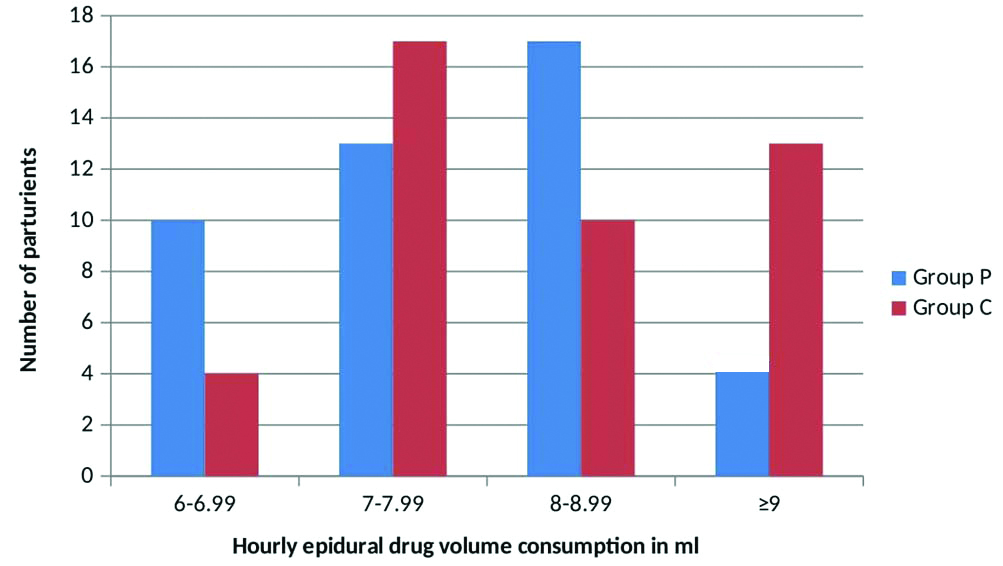
Total number of demand boluses needed.
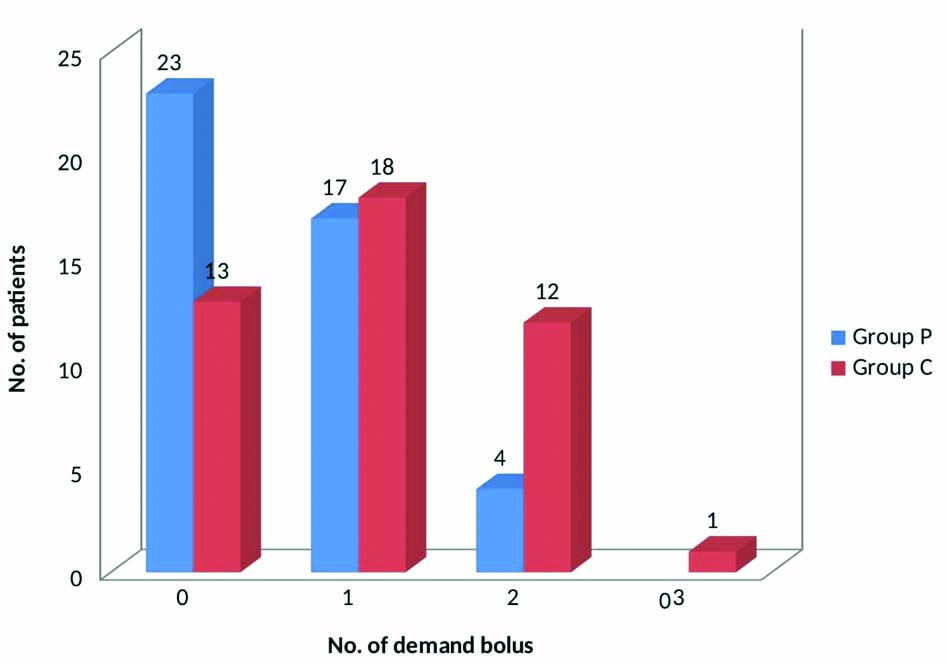
Mean number of demand top-ups was significantly lower in group P (0.58±0.66) than control group (1.02±0.82); p-value 0.005 [Table/Fig-5].
Epidural drug consumption.
| Parameter | Group P | Group C | p-value (unpaired student’s t-test) |
|---|
| Total duration of continuous infusion in minutes | 139.45±18.84 | 142.84±19.74 | 0.441 |
| Total volume (mL) of epidural drug consumed from t=30 minutes till delivery | 22.09±4.73 | 23.95±5.6 | 0.081 |
| Mean hourly epidural drug volume consumption in mL/hr | 7.75±0.93 | 8.23±0.99 | 0.022 |
| Number of demand top-ups | 0.58±0.66 | 1.02±0.82 | 0.005 |
Patients in both groups had high pain scores before the study drug was infused (Group P: 6.25±0.89 vs Group C: 6.20±1.02; p=0.807) with no statistically significant difference. VAS score was similar in both groups at all the times except at 0 minute. At t=0, VAS in group P was lower than group C (p=0.001). Quality of pain relief was adequate with VAS of ≤30 mm at all the time intervals after first 10 minutes in both the groups [Table/Fig-6].
VAS values at different time intervals.
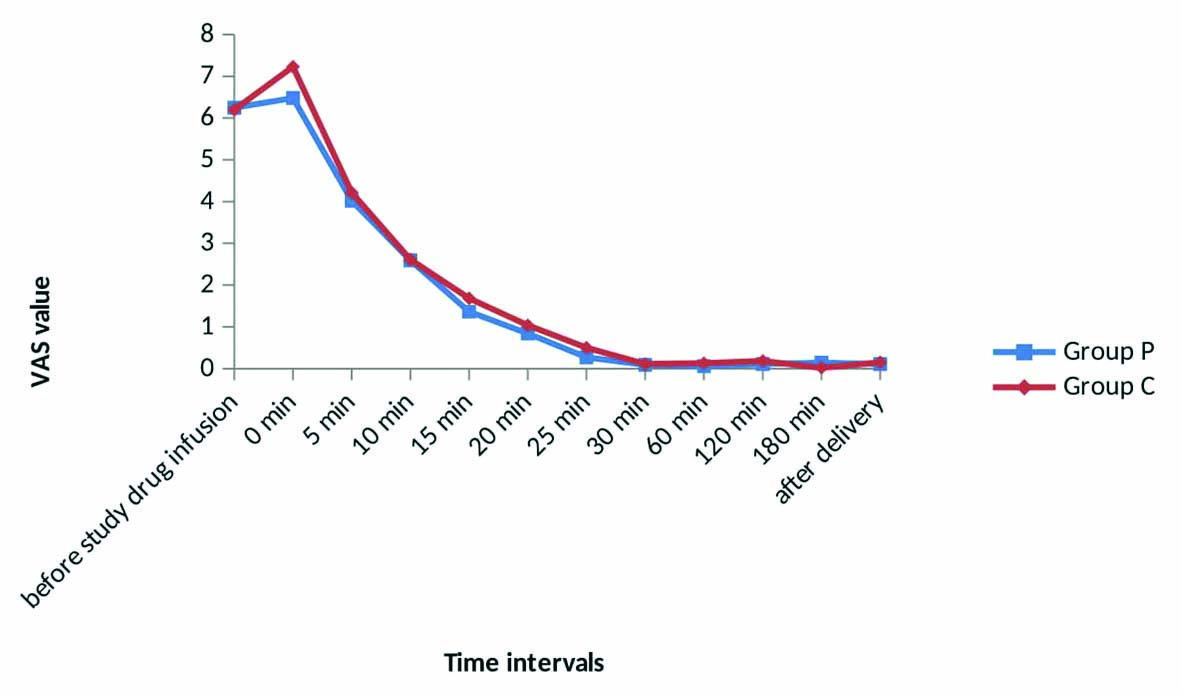
Mean time for onset of analgesia was similar in both groups (11.22±3.13 min and 11.45±4.90 min in groups P and C respectively; p-value=0.796) [Table/Fig-7].
Epidural block characteristics and course of labour.
| Parameters | Group P | Group C | p-value |
|---|
| Onset of analgesia (minutes) | 11.22±3.13 | 11.45±4.90 | 0.796 (Unpaired student’s t-test) |
| Duration of 2nd stage of labour (minutes) | 39.43±8.08 | 41.59±7.75 | 0.204 (Unpaired student’s t-test) |
| Maximum height of sensory level achieved (T6:T8) | 12:32 | 10:34 | 0.622 (Chi-square test) |
| Mode of deliveryVaginal/Caesarean/Forceps | 41/2/1 | 40/4/0 | 0.432 (Chi-square test) |
| APGAR SCORE at |
| 1 minute | 7.70±0.82 | 7.77±0.83 | 0.7 (Unpaired student t test) |
| 5 minutes | 9.68±0.47 | 9.59±0.54 | 0.403 (Unpaired student’s t-test) |
| Parturient satisfaction(Excellent: good: fair) | 30: 10: 4 | 26:12: 6 | 0.648 (Chi-square test) |
The median highest level of sensory block was T8, thus attaining adequate level of analgesia in both the groups. In all the parturients no motor blockade was seen and Modified Bromage Grade was zero at all times.
Among group P, 2 (4.5%) required caesarean section and 1 (2.27%) required forceps delivery. Whereas in control group, 4 (9.1%) required caesarean section and rest had normal vaginal delivery [Table/Fig-7]. Maternal heart rate (92.20±0.68 beats per minute (bpm) versus 92.54±1.08 bpm in group P and group C, respectively; p-value=0.39) and mean blood pressure (78.8±0.26 mmHg versus 78.94±0.23 mmHg in group P and group C, respectively; p-value=0.20) [Table/Fig-8] were comparable in both groups at all times. Similarly, maternal satisfaction score and neonatal outcomes i.e., FHR and median APGAR scores at 1 and 5 minutes were also comparable in both groups.
Maternal Mean Blood Pressure (MBP) in mmHg and maternal Heart Rate (HR).
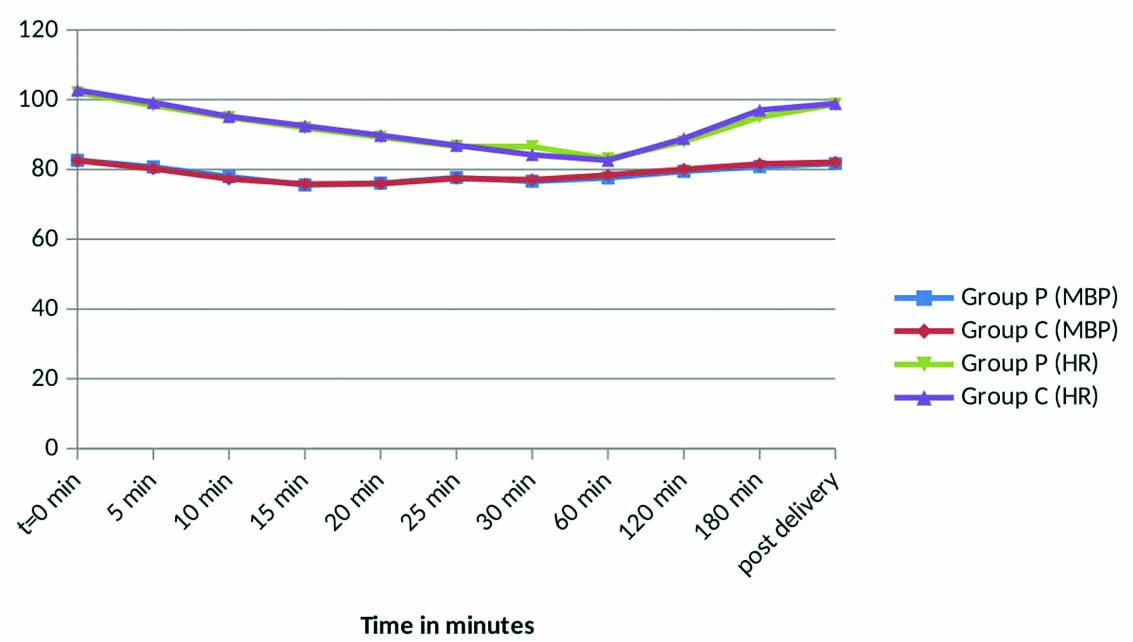
Adverse effects were minor in this study and consisted mainly of nausea, vomiting and urinary retention. There were no significant differences in occurrence of side-effects between the two groups [Table/Fig-9].
Adverse effects in two groups.
| Adverse effects | Group P | Group C | p-value (unpaired student’s t-test) |
|---|
| Foetal bradycardia | 1 | 2 | 1.00 |
| Hypotension | 1 | 0 | 1.00 |
| Urinary retention | 1 | 2 | 1.00 |
| Nausea | 5 | 4 | 1.00 |
| Vomiting | 1 | 0 | 1.00 |
| Pruritis | 0 | 1 | 1.00 |
| Fever | 0 | 2 | 0.494 |
Discussion
The PCEA, a well-accepted technique of administering epidural labour analgesia which improves maternal analgesia and parturient satisfaction with the use of lowest possible effective doses of local anaesthetics, thereby leading to minimal motor blockade and probable favourable effect on mode of delivery [19]. This formed the basis of the use the PCEA technique with background infusion of 5 mL/h in this study.
In the present study, 1000 mg i.v. paracetamol significantly decreased hourly mean epidural drug volume consumption. Although the background infusion was same in both the groups, the number of demands top up boluses were significantly less in paracetamol group thus proving the epidural drug dose sparing effect of paracetamol during active labour. Present study results were similar to findings by Gupta K et al., who studied the analgesic and epidural drug volume sparing effects of i.v. paracetamol in 80 labouring patients [16]. They reported that hourly mean drug consumption in the paracetamol group was significantly lower as compared with the placebo group (7.03±0.83 ml/hr vs. 8.12±1.34 mL/hr; p<0.001). In the same study, mean number of boluses taken were also significantly less in the paracetamol group (1.00±0.93 vs. 1.43±0.90; p=0.036) signifying the epidural drug sparing effects of i.v. paracetamol.
VAS scores in both groups were similar before study drug was administered. At t=0, that is 30 minutes after study drug administration and just after epidural induction (i.e., prior to epidural analgesia onset), VAS was significantly lower in paracetamol receiving parturients. This is explained by the analgesic effect of paracetamol only, as at t=0, epidural analgesia was not present; and analgesic effect of paracetamol has onset in 5-10 minutes, peak effect at one hour and lasts for 4-6 hours [20]. Similar findings have been reported by Zutshi V et al., who studied analgesic effects of i.v. paracetamol in 200 labouring patients who were not receiving any other form of analgesia [13]. They reported lower VAS scores in paracetamol receiving labouring patients than controls.
VAS scores were less than 3 at all times after 10 minutes of first epidural bolus signifying the adequate analgesia in all parturients. The statistically significant difference in top up boluses and mean hourly drug consumption may be explained by superior analgesia in paracetamol group which allowed parturients to require less additional boluses for adequate analgesia resulting in non significant difference in VAS score in both groups. This showed that to achieve the similar level of analgesia parturients receiving i.v. paracetamol needed less epidural drug as compared to patients in control group.
Although considered to be the gold standard for labour analgesia for several decades, epidural local anaesthetic opioid combination is associated with inherent side-effects of drugs used. Dose dependent local anaesthetic induced haemodynamic instability and motor blockade leading to operative deliveries is well known and well explained. The synergy between neuraxially administered opioid and local anaesthetic medications allows dose-reduction of both drugs, minimising side-effects [21] but neuraxial opioids are associated with increased chances of foetal bradycardia and maternal pruritis [22,23]. So it has been always a goal to limit epidural local anaesthetic opioid drug as much as possible with any adjunct. Present study showed that i.v. paracetamol has epidural local anaesthetic opioid sparing effect, which could have favourable implications for both the mother and the baby. Thus, local anaesthetic opioid sparing effect of i.v. paracetamol, may be a welcome addition to the already existing gold standard of labour analgesia.
As regards the secondary outcome measures, there was no significant difference in maternal haemodynamics, duration of labour and mode of delivery between groups. Similar findings were reported by Gupta K et al., [16]. These findings were also consistent with Cochrane Database Systemic trials which compared the progress of labour between epidurals discontinued late in labour and continuous epidural infusion during second stage of labour [24,25], though these systemic reviews included a number of different epidural local anaesthetics and opioids in variable doses.
Also, neonatal outcomes were similar in both the groups. Although not shown in any table or figure, FHR and median Apgar scores at 1 and 5 minutes among both groups did not showed any statistically significant variation. Foetal bradycardia was noted in one patient in paracetamol group and two patients in control group. Similar findings have been reported by Elbohoty AE et al., Gupta K et al., and Abd-El-Maeboud KH et al., who demonstrated no differences in occurrence of intrapartum foetal distress or neonatal Apgar scores in patients receiving paracetamol [8,16,26]. The recent Cochrane meta-analysis, too reports no adverse neonatal outcome in labour epidural deliveries [24].
Maternal adverse effects were minor in this study and consisted mainly of nausea, vomiting and urinary retention. There were no significant differences in occurrence of side-effects between the two groups, confirming the safety and tolerability of paracetamol reported in other studies.
Limitation(s)
Having study data withdrawn from a small study population over a short span of time at a single centre, its results may not be representative of general population. So, multicentre studies with large population are needed to make precise conclusions about epidural drug dose sparing effects of i.v. paracetamol in labour.
Conclusion(s)
The observations from present study may be concluded that i.v. paracetamol is safe and effective drug for intrapartum analgesia with significant epidural local anaesthetic- opioid dose sparing effects and negligible side-effects when used along with PCEA. By allowing the use of lower doses of epidurally administered drugs and therefore minimising their undesirable side-effects, i.v. paracetamol can be an integral part of intrapartum PCEA.
SD: Standard deviation